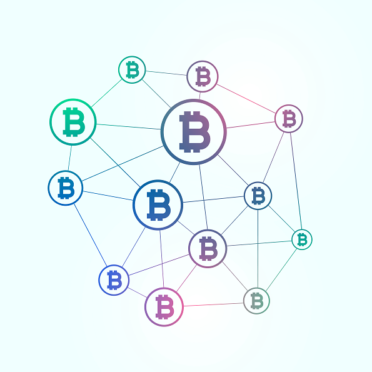What is blockchain: Demystifying the technology behind Bitcoin

If you had a dollar for every time you heard the word ‘cryptocurrency’ in the past few months, would you be a bit richer?
With cryptocurrency in the limelight, there has been a rising interest in the technology behind it called blockchain. If you have been trying to understand what is blockchain but are not getting anywhere with it, then this article is for you.
What is blockchain
A simple blockchain definition would be –
Blockchain is a set of blocks containing data that is secured with cryptography.
If you are scratching your head about what is a block, then here’s what that means –
A block is a set of bit/bytes that can be used to store information.
Once the information is stored in a block, it is added to the previous block, thus creating a chain and giving it the name blockchain.
Each blockchain is secured with cryptography, and every block contains 2 hashes. The 1st hash is the unique identity of the block while the 2nd hash is the identity of the previous block, which creates a link between the 2 blocks. Any changes made to the data in the block changes its hash and it becomes a new block. This makes it easy to detect changes and makes blockchain technology super secure.
Now that we understand the blockchain basics, let’s get a wee bit technical.
Because of its widespread use in cryptocurrency, blockchain is also referred to as distributed ledger technology. Sounds fancy, but what the heck does that even mean?
A distributed ledger system is used to make transactions as we do in banking. For example, imagine Paranita wants to send money to Ruth. Conventionally, this transaction is verified and recorded by the bank. However, in the case of Bitcoin, this transaction is verified by different computers on the network called ‘nodes’.Think of it as many people agreeing about the validity of a transaction. Once verified, these transactions are recorded and can be viewed by anyone in the Bitcoin network. However, they are immutable and cannot be altered easily.
In a distributed ledger system, there is no central organisation or person who is in control of the information. Rather, it is distributed across a network of various computers, thus giving control to people in the network. This adds more transparency to the process.
What are the uses of blockchain?
Although blockchain technology was developed in 1991, it got popular in 2009 when the first digital currency Bitcoin was created. This is, however, just one of the many uses of blockchain. It is also used in other fields such as maintaining medical records, maintaining real estate records, voting, etc. This is possible because blocks can contain different kinds of information. This information can then have varying levels of accessibility depending on the type of blockchain.
What are the types of blockchain?
1. Public blockchain
Public blockchains are accessible to anyone with an internet connection. Once they have logged into the blockchain, they can view all the transactions from past to the present. They can, however, not change any of it.
This type of blockchain is decentralised and spread across a large network of computers. So, instead of having a central place for recording the information, they have a peer-to-peer network. In order for this blockchain to be hacked, the hackers would have to gain control of 51% of the network which is a difficult task. This makes it trustworthy and secure.
Cryptocurrencies work on this model. However, it is not suitable for private companies who may want to restrict access.
2. Private blockchain
Like the public blockchain, this also works on the decentralisation model. However, it works on a smaller network such as a company network and the identity of every blockchain member is known. Unlike public blockchains, the company can also choose who can view or alter the data. This helps the companies in restricting access to sensitive information.
Private blockchains are used in medical records to maintain patient confidentiality.
3. Hybrid
This is a mix of both public and private blockchains. Certain data can be viewed by the public, however, other data remains private.
Hybrid blockchains are used in retail.
4. Consortium
It is a blockchain that is controlled and used by multiple organisations.
This is often used in the banking industry.
What are some blockchain careers that you can explore?
Besides the cryptocurrency universe, many industries have started leveraging blockchain technology. So if you are fascinated by the field, you can explore the following careers in blockchain:
1. Blockchain engineer
Blockchain engineers conceptualise decentralised applications (dApps) that work on blockchain technology.
2. Blockchain developer
While the engineers conceptualise blockchain solutions, developers implement them through coding. They are responsible for building blockchain applications and smart contracts.
This could be a great entry-level position for anyone who is starting out in the blockchain industry.
3. Blockchain designer
Blockchain is a new technology that a lot of people are just starting to get familiar with or will need to get familiar with. Therefore, it will become imperative for companies to hire user experience designers for blockchain applications.
Since blockchain is still an emerging field, UX design is a challenge. So, it can be an exciting opportunity for anyone looking to explore an uncharted territory.
4. Blockchain architect
A blockchain architect designs the end-to-end blockchain solution. They have to make sure that the solution meets business goals, lies within the budget, and has smooth workflows between teams.
5. Blockchain quality engineer
They are responsible for quality assurance. They make sure that the applications are secure and bug free.
Eager to learn blockchain? Then, enroll in Internshala’s Blockchain training, block some time on your calendar to learn everyday, and enter the groundbreaking world of blockchain! Use BLOG10 to get a discount of 10%.
Image credits: <a href=’https://www.freepik.com/free-photos-vectors/background’>Background vector created by starline – www.freepik.com</a>



